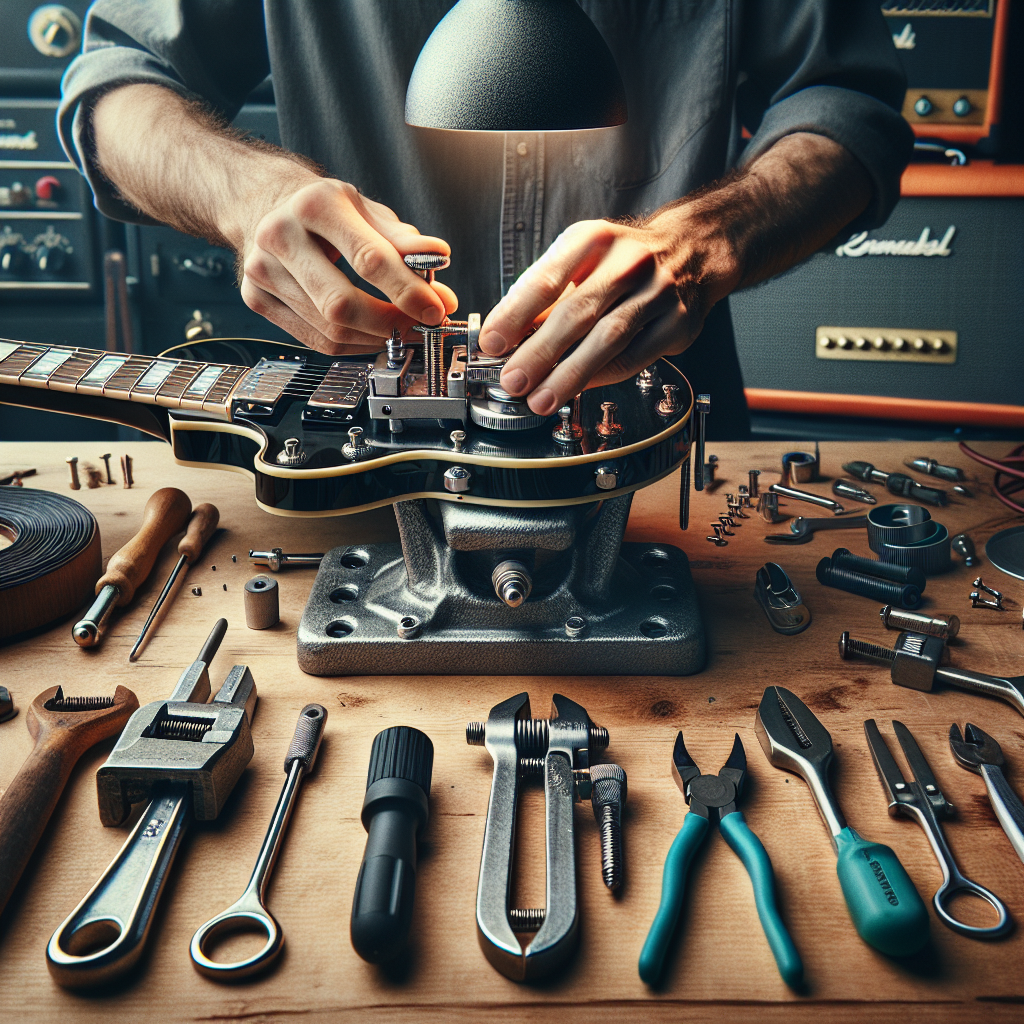
10 Steps to Install a Bigsby Vibrato System: Master Your Guitar Tone
As a guitarist, you may often look for ways to expand the tonal possibilities of your instrument, bringing new life into your playing style. One such way is installing a Bigsby vibrato system. Famous for its smooth, vintage sound, the Bigsby vibrato can add a unique flair to your performance. This guide will walk you through the process of installing a Bigsby vibrato system on your guitar, ensuring it sits perfectly with your instrument’s aesthetic and sound needs.
1. Gather the Necessary Tools
Before starting the installation, ensure you have all the required tools and materials. You’ll need a screwdriver set, a drill, masking tape, a ruler, and a pencil. Additional items like a power drill with appropriate bits and a small wrench may also come in handy. Ensure you have a soft cloth or towel to protect your guitar’s finish during the installation process.
2. Choose the Right Bigsby Model
Picking the correct Bigsby vibrato system for your guitar is crucial. Different models cater to various guitar types. Whether you have a solid-body, semi-hollow, or hollow-body guitar, there’s a fitting Bigsby model for you. Verify compatibility with your guitar’s make and model to avoid unnecessary hassle during the installation.
3. Prepare Your Guitar
Start by removing the strings to prevent them from obstructing the installation. Use masking tape to mark the bridge’s current position for accurate reinstallation later. Clean the guitar’s surface to ensure no dirt interferes with the process, and lay down a soft cloth to protect your instrument from scratches.
4. Install the Hinge Plate
Next, attach the Bigsby’s hinge plate to the lower part of your guitar’s body. Align it properly before marking the screw holes with a pencil. Carefully drill pilot holes using a low-power setting to prevent cracking the guitar’s finish. Once complete, securely screw the hinge plate into place, avoiding over-tightening.
5. Attach the Bigsby System
With the hinge plate installed, align the Bigsby vibrato unit over it. Secure the vibrato by tightening the screws into the pre-drilled holes. Ensure it’s firmly attached without warping the guitar’s surface. Check for proper alignment and adjust as necessary before tightening fully.
6. Reinstall the Bridge
Replace the bridge using the marks you made earlier. Refer to the bridge specifications specific to your guitar model to ensure proper intonation and alignment with the Bigsby. You may need to adjust the bridge height or position once the strings are back on.
7. Restring the Guitar
Restring your guitar, threading the strings through the roller bar on the Bigsby. This can be a bit tricky, so patience is key. Ensure the strings sit correctly in their respective slots and pull them through gently to avoid them slipping out during the process.
8. Tune and Test the System
With the strings installed, tune your guitar to your preferred tuning. Test the Bigsby for smooth operation, ensuring no unwanted noise or slipping occurs. Make any necessary adjustments to achieve optimal performance. Remember, a properly installed Bigsby should offer smooth operation without affecting the overall tuning stability.
9. Maintenance and Care
To maintain your Bigsby’s performance over time, routinely check for loose screws and lubricate moving parts with a suitable lubricant. Regular maintenance prolongs the life of both the vibrato and your guitar, ensuring peak performance and sound quality.
10. Troubleshooting Common Issues
If you encounter tuning stability issues, check the nut slots and consider wider slots or lubrication. For rattling sounds, ensure all screws are tightly fastened and the bridge is correctly aligned. Do not hesitate to consult a professional if you encounter persistent issues or are unsure about any installation step.
FAQs
1. What is a Bigsby vibrato system?
A Bigsby vibrato system is a mechanical device installed on electric guitars, allowing guitarists to produce vibrato effects by altering string tension. It’s known for its subtle and smooth effect, offering a vintage aesthetic and sound.
2. How difficult is it to install a Bigsby?
The difficulty depends on your familiarity with guitar hardware. Basic knowledge and careful planning can make the installation manageable. For those uncertain, professional installation is recommended.
3. Will a Bigsby affect my guitar’s tuning?
While Bigsby vibratos are known for their tuning stability, incorrect installation can lead to tuning issues. Ensure the strings, nut, and bridge are correctly set up to maintain tuning stability.
4. Which guitars are compatible with Bigsby systems?
Bigsby vibratos are versatile and can be installed on various guitar types, including solid body, semi-hollow, and hollow-body guitars. Checking compatibility with your specific guitar model is crucial.
5. Can I install a Bigsby myself, or should I seek professional help?
If you are comfortable with guitar modifications, you can install the Bigsby yourself. Otherwise, seeking professional help ensures precise installation and avoids potential damage.
6. How does a Bigsby differ from other vibrato systems?
Bigsby vibratos produce a subtle and smooth vibrato effect, unlike other systems that can offer more aggressive modulation. This makes them suitable for vintage-sounding music and nuanced tonal adjustments.
In conclusion, installing a Bigsby vibrato system can significantly enhance your guitar’s aesthetic and tonal qualities. By following the outlined steps and taking care during installation, you can achieve a professional result that elevates your playing experience. Whether you do it yourself or seek professional help, the Bigsby system opens new avenues for creative expression in your music.
For more information on guitar modifications and improvements, consider visiting Fender’s Tech Talk for expert advice and tips.